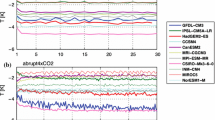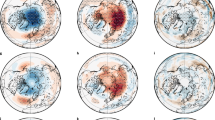Abstract
Using a detailed, fully coupled chemistry climate model (CCM), the effect of increasing stratospheric H2O on ozone and temperature is investigated. Different CCM time-slice runs have been performed to investigate the chemical and radiative impacts of an assumed 2 ppmv increase in H2O. The chemical effects of this H2O increase lead to an overall decrease of the total column ozone (TCO) by ∼1% in the tropics and by a maximum of 12% at southern high latitudes. At northern high latitudes, the TCO is increased by only up to 5% due to stronger transport in the Arctic. A 2-ppmv H2O increase in the model’s radiation scheme causes a cooling of the tropical stratosphere of no more than 2 K, but a cooling of more than 4 K at high latitudes. Consequently, the TCO is increased by about 2%–6%. Increasing stratospheric H2O, therefore, cools the stratosphere both directly and indirectly, except in the polar regions where the temperature responds differently due to feedbacks between ozone and H2O changes. The combined chemical and radiative effects of increasing H2O may give rise to more cooling in the tropics and middle latitudes but less cooling in the polar stratosphere. The combined effects of H2O increases on ozone tend to offset each other, except in the Arctic stratosphere where both the radiative and chemical impacts give rise to increased ozone. The chemical and radiative effects of increasing H2O cause dynamical responses in the stratosphere with an evident hemispheric asymmetry. In terms of ozone recovery, increasing the stratospheric H2O is likely to accelerate the recovery in the northern high latitudes and delay it in the southern high latitudes. The modeled ozone recovery is more significant between 2000–2050 than between 2050–2100, driven mainly by the larger relative change in chlorine in the earlier period.
Similar content being viewed by others
References
Austin, J., N. Butchart, and K. P. Shine, 1992: Possibility of an Arctic ozone hole in a doubled-CO2 climate. Nature, 360, 221–225.
Austin, J., N. Butchart, and J. Knight, 2000: Three-dimensional chemical model simulations of the ozone layer: 1979–2015. Quart. J. Roy. Meteor. Soc., 126, 1533–1556.
Austin, J., N. Butchart, and J. Knight, 2001: Three-dimensional chemical model simulations of the ozone layer: 2015–2055. Quart. J. Roy. Meteor. Soc., 127, 959–974.
Chipperfield, M. P., 1999: Multiannual simulation with a three-dimensional chemical transport model. J. Geophys. Res., 104, 1781–1805.
Cullen, M. J. P., 1993: The unified forecast/climate model. Meteor. Mag., 122, 81–94.
Dameris, M., V. Grewe, R. Hein, C. Schnadt, C. Bruhl, and B. Steil, 2001: Assessment of the future development of the ozone layer. Geophys. Res. Lett., 25, 3579–3582.
Dvortsov, V., and S., Solomon, 2001: Response of the stratospheric temperatures and ozone to past and future increases in stratospheric humidity. J. Geophys. Res., 106, 7505–7514.
Evans, S. J., R. Toumi, J. E. Harries, M. P. Chipperfield, and J. M. Russel III, 1998: Trends in stratospheric humidity and the sensitivity of ozone to these trends. J. Geophys. Res., 103, 8715–8725.
Forster, P. M. de F., and K. P. Shine, 1999: Stratospheric water vapor changes as a possible contributor to observed stratospheric cooling. Geophys. Res. Lett., 26, 3309–3312.
Forster, P. M. de F., and K. P. Shine, 2002: Assessing the climate impact of trend in stratospheric water vapor. Geophys. Res. Lett., 29, doi: 10.1029/2001GL013909.
Kirk-Davidoff, D. B., E. J. Hintsa, J. G. Anderson, and D. W. Keith, 1999: The effect of climate change of ozone depletion through changes in stratospheric water vapour. Nature, 402, 399–401.
Logan, J. A., 1999: An analysis of ozone sonde data for the troposphere recommendations for testing 3-D models, and development of a gridded climatology for tropospheric ozone. J. Geophys. Res., 104, 16115–16149.
Nedoluha, G. E., and Coauthors, 1998: Increases in middle atmospheric water vapor as observed by HALOE and the ground based Water Vapor Millimeter-wave Spectrometer from 1991–1997. J. Geophys. Res., 103, 3531–3543.
Oinas, V., A. A., Lasis, D., Rind, D. T., Shindell, and J. E., Hansen, 2001: Radiative cooling by stratospheric water vapor: Big difference in GCM results. Geophys. Res. Lett., 28, 2791–2794.
Oltmans, S. J., H. Vomel, D. J. Hofmann, K. H. Rosenlof, and D. Kley, 2000: The increase in stratospheric water vapor from balloon-borne, frostpoint hygrometer measurements at Washington, D. C., and Boulder, Colorado. Geophys. Res. Lett., 27, 3453–3456.
Pitari, G., S. Palermi, G. Visconti, and R. G. Prinn, 1992: Ozone response to a CO2 doubling: Results from a stratospheric circulation model with heterogeneous chemistry. J. Geophys. Res., 97, 5953–5962.
Rind, D., and P. Logergan, 1995: Modelled impacts of stratospheric ozone and water vapor perturbations with implications for high-speed civil transport aircraft. J. Geophys. Res., 100, 7381–7396.
Rosenfield, J. E., A. R. Douglass, and D. B. Considine, 2002: The impact of increased carbon dioxide on ozone recovery. J. Geophys. Res., 107(D6), doi: 10.1029/2001JD000824.
Shine, K. P., and Coauthors, 2003: A comparison of model-simulated trends in stratospheric temperature. Quart. J. Roy. Meteor. Soc., 129, doi: 10: 1256/qj.02.186.
Shindell, D. T., 2001: Climate and ozone response to increased stratospheric water vapor. Geophys. Res. Lett., 28, 1551–1554.
Shindell, D. T., and V. Grewe, 2002: Separating the influence of halogen and climate changes on ozone recovery in the upper stratosphere. J. Geophys. Res., 107(D12), doi: 10.1029/2001JD000420.
Shindell, D. T., D. Rind, and P. Lonergan, 1998: Increased polar stratospheric ozone losses and delayed eventual recovery owing to increasing greenhouse-gas concentrations. Nature, 392, 589–592.
Smith, C. A., J. D. Haigh, and R. Toumi, 2001: Radiative forcing due to trends in stratospheric water vapor. Geophys. Res. Lett., 28, 179–182.
Stuber, N., M. Ponater, and R. Sausen, 2001: Is the climate sensitivity to ozone perturbations enhanced by stratospheric water vapor feedback. Geophys. Res. Lett., 28, 2887–2890.
Stenke, A., and V. Grewe, 2005: Simulation of stratospheric water vapor trends: Impact on stratospheric ozone chemistry. Atmosphric Chemistry and Physics, 5, 1257–1272.
Tabazadeh, A., M. L. Santee, M. Y. Danlin, H. C. Pumphrey, P. A. Newman, P. J. Hamill, and J. L. Mergenthaler, 2000: Quantifying denitrification and its effect on ozone recovery. Science, 288, 1407–1411.
Tian, W. S., and M. P. Chipperfield, 2004: A new coupled chemistry-climate model for the stratosphere: The importance of coupling for future O3-climate predictions. Quart. J. Roy. Meteor. Soc., 131, 281–303, doi: 10.1256/qj.04.05.
Tian, W. S., and M. P. Chipperfield, 2006: Stratospheric water vapor trends in a coupled chemistryclimate model. Geophys. Res. Lett., 33, L06819, doi: 10.1029/2005GL024675.
World Meteorological Organization, 2003: Scientific Assessment of Ozone Depletion: 2002. WMO Global Ozone Research and Monitoring Project-Report No. 47, Geneva, Switzerland, 498pp.
Author information
Authors and Affiliations
Corresponding author
Rights and permissions
About this article
Cite this article
Tian, W., Chipperfield, M.P. & Lü, D. Impact of increasing stratospheric water vapor on ozone depletion and temperature change. Adv. Atmos. Sci. 26, 423–437 (2009). https://doi.org/10.1007/s00376-009-0423-3
Received:
Revised:
Published:
Issue Date:
DOI: https://doi.org/10.1007/s00376-009-0423-3




